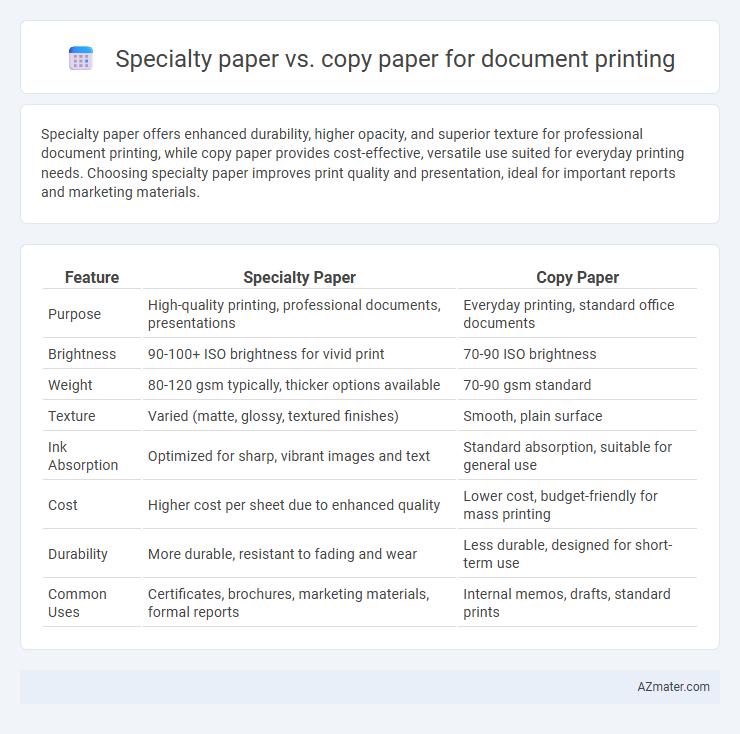Specialty paper offers enhanced durability, higher opacity, and superior texture for professional document printing, while copy paper provides cost-effective, versatile use suited for everyday printing needs. Choosing specialty paper improves print quality and presentation, ideal for important reports and marketing materials.
Table of Comparison
| Feature | Specialty Paper | Copy Paper |
|---|---|---|
| Purpose | High-quality printing, professional documents, presentations | Everyday printing, standard office documents |
| Brightness | 90-100+ ISO brightness for vivid print | 70-90 ISO brightness |
| Weight | 80-120 gsm typically, thicker options available | 70-90 gsm standard |
| Texture | Varied (matte, glossy, textured finishes) | Smooth, plain surface |
| Ink Absorption | Optimized for sharp, vibrant images and text | Standard absorption, suitable for general use |
| Cost | Higher cost per sheet due to enhanced quality | Lower cost, budget-friendly for mass printing |
| Durability | More durable, resistant to fading and wear | Less durable, designed for short-term use |
| Common Uses | Certificates, brochures, marketing materials, formal reports | Internal memos, drafts, standard prints |
Understanding Specialty Paper and Copy Paper
Specialty paper includes various types designed for specific printing needs, such as glossy photo paper, cardstock, and textured papers, providing enhanced print quality and durability. Copy paper, typically a standard wood-pulp paper with a brightness level around 92-96, is optimized for everyday document printing, balancing cost and performance for laser and inkjet printers. Understanding the differences in weight, finish, and coating helps select the appropriate paper type for professional or casual printing tasks.
Key Differences Between Specialty and Copy Paper
Specialty paper differs from copy paper by offering unique textures, finishes, and weights designed for specific printing needs such as photo printing, invitations, or labels, providing enhanced durability and color reproduction. Copy paper is typically lightweight, smooth, and plain, optimized for high-speed printing and everyday document use with standard ink or toner. The key distinctions lie in specialty paper's variable thickness and surface coatings compared to copy paper's uniformity, affecting print quality, paper handling, and intended application.
Print Quality: Specialty vs. Copy Paper
Specialty paper offers superior print quality compared to standard copy paper, providing sharper image resolution and richer color vibrancy, ideal for professional documents and marketing materials. Copy paper is designed for everyday printing with adequate clarity and consistency but often lacks the brightness and texture needed for high-detail or color-critical prints. For projects requiring enhanced visual impact and durability, specialty paper significantly outperforms copy paper in delivering professional-grade results.
Durability and Longevity of Printed Documents
Specialty paper offers superior durability and longevity for document printing due to its higher GSM weight, acid-free composition, and enhanced resistance to fading and moisture compared to standard copy paper. These properties make specialty paper ideal for archival documents, certificates, and important records requiring long-term preservation. Copy paper, typically thinner and more porous, is prone to faster degradation and ink bleed, reducing the lifespan of printed materials.
Cost Comparison: Which Paper Offers Better Value?
Specialty paper generally costs significantly more than standard copy paper due to its enhanced qualities like texture, thickness, or finish, impacting overall printing expenses. Copy paper offers better value for everyday document printing by balancing quality and affordability, especially in high-volume environments. Businesses seeking premium appearance and durability must weigh higher costs against the functional benefits specialty paper provides.
Best Uses for Specialty Paper in Document Printing
Specialty paper offers enhanced texture, weight, and finish options that elevate the presentation of important documents such as resumes, certificates, and marketing materials. Its higher opacity and durability ensure sharper print quality and increased resistance to wear, making it ideal for professional reports, invitations, and promotional flyers. Unlike standard copy paper, specialty paper supports various printing techniques including embossing and foil stamping, providing a premium and lasting impression.
When to Choose Copy Paper for Your Printing Needs
Copy paper is ideal for everyday document printing, offering reliability and cost-effectiveness for large volumes of text-based materials such as reports, memos, and drafts. This paper type typically has a standard brightness and weight, ensuring smooth feeding through standard printers and copiers without causing jams or excessive wear. Choose copy paper when high-quality color reproduction or unique textures are unnecessary, prioritizing efficiency and affordability for routine office tasks.
Environmental Impact and Sustainability
Specialty paper often incorporates recycled fibers and environmentally friendly coatings, reducing resource consumption and landfill waste compared to standard copy paper. Copy paper typically requires higher energy and water usage during production, contributing to greater carbon emissions and environmental degradation. Selecting sustainably sourced specialty paper with certifications like FSC or PEFC supports responsible forestry and minimizes the ecological footprint of document printing.
Professional Appearance and Finishing Touches
Specialty paper enhances professional appearance by offering higher quality textures, colors, and finishes that elevate printed documents beyond standard expectations. Unlike copy paper, specialty paper supports crisp, vibrant ink absorption and smooth surfaces ideal for important presentations, resumes, and marketing materials. Choosing specialty paper ensures a refined finishing touch, conveying attention to detail and reinforcing brand prestige in every printed page.
Making the Right Choice for Your Document Printing
Selecting the right paper for document printing involves considering factors such as print quality, durability, and purpose. Specialty paper offers enhanced features like textured finishes, higher weight, and color vibrancy, ideal for presentations, professional reports, or marketing materials, while copy paper provides an economical, reliable option for everyday printing and drafts. Evaluating the importance of image clarity, archival requirements, and cost efficiency helps determine whether specialty or copy paper best suits your specific document printing needs.

Infographic: Specialty paper vs Copy paper for Document printing
 azmater.com
azmater.com